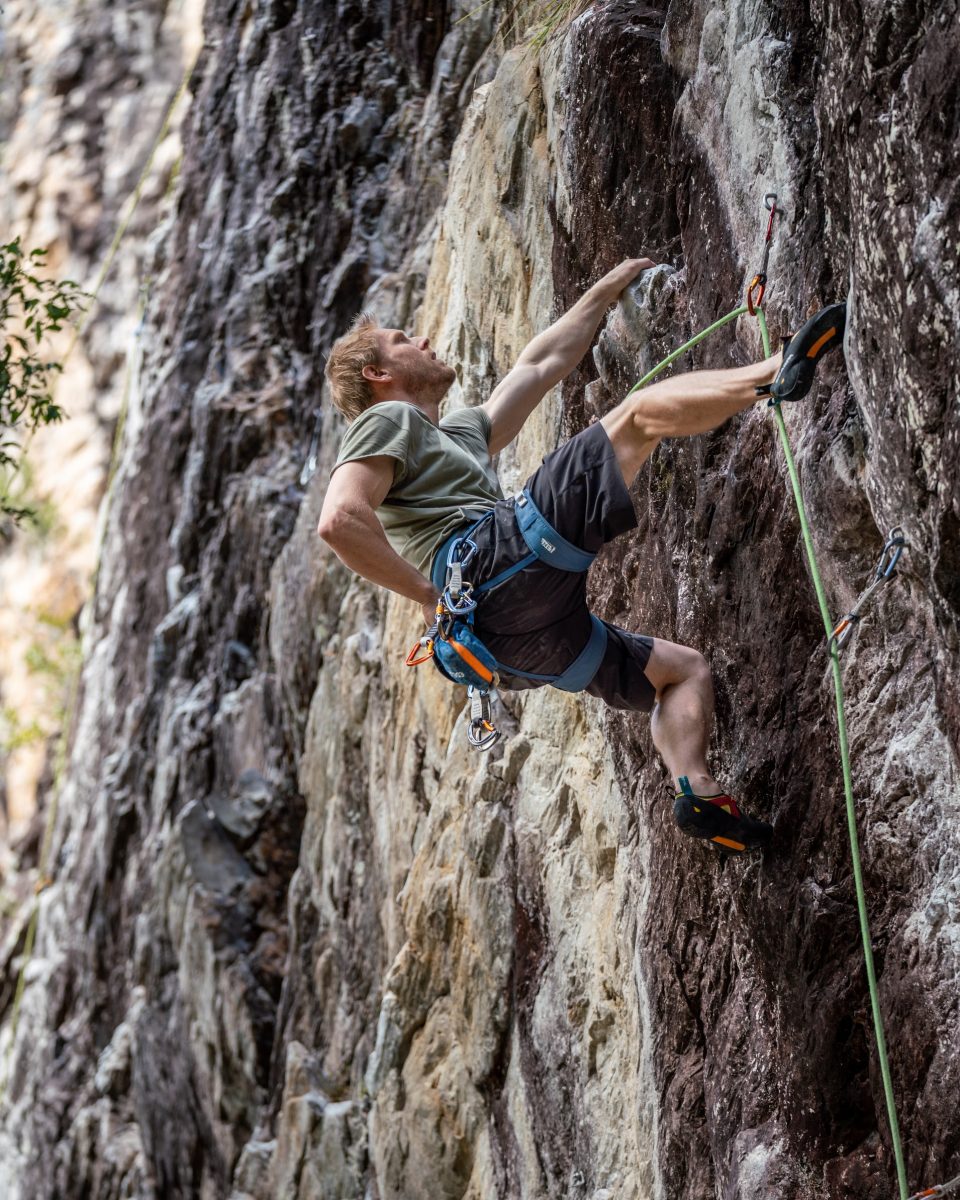Transition From Plastic to Real Rock

The journey from colourful plastic to natural stone is a big leap for most climbers. Climbing outdoors offers greater opportunities and heightened difficulty, but it also requires an altered approach, additional knowledge and more equipment. The challenge for the modern climber is navigating the transition from their local gym to their local crag, and ensuring they have the skills and gear to do so safely.
We remember this period well – the nerves, the heavy backpacks and the YouTube tutorials… That’s why we want to share a basic guide to help you route-find your way into outdoor climbing.
The Basic Types of Outdoor *Free Climbing
Sport Climbing
Sport Climbing is probably the most common type of ‘roped’ climbing, as it relies upon permanent fixed anchors on the rock for safety. There are two types of Sport Climbing;
- Lead Climbing
This type of climbing requires the climber (or “leader”) to climb a route and clip their rope to bolts as they go using Quickdraws. In the event they fall, their belayer, using the rope and a belay device, will catch them.
- Top Roping
This type of climbing involves fixing the rope at the top of a route, also known as the “anchors”. This way the climber can tie into one end and the belay takes up slack on the other end, ensuring the climber can weight the rope whenever.
The Basic Gear Needed for Sport Climbing
- Rope (60 metres or more)
- 8-12 Quickdraws
- Belay Device
- Locking Carabiners
- Harness
- Helmet
- Climbing Shoes
- Chalk Bag
- Personal Anchor System (PAS)

Bouldering
By far the least gear intensive form of climbing, Bouldering involves climbers attempting shorter climbs (generally no higher than 4 metres) on boulders or rocks faces. These climbs are called “Boulder Problems” and climbers use crash pads to protect themselves in the event they fall.
The Basic Gear Needed for Bouldering
- Climbing Shoes
- Chalk Bag/Bucket
- Crash Pad/s
- Brush

Traditional Climbing
Traditional Climbing, or simply ‘trad’, involves climbers using natural protection to protect routes; these pieces of protection can be passive (nuts, hexes) or active (camming devices) and are removable. By placing these devices in natural weakness in the rock, such as cracks, pockets or slots, a climber can ascend routes with no fixed protection.
The Basic Gear Needed for Trad Climbing
- Rope (Twin Ropes can be useful)
- 8-10 Lightweight Quickdraws
- 4-6 Extendable Quickdraws
- Belay Device
- Locking Carabiners
- Harness
- Helmet
- Climbing Shoes
- Chalk Bag
- Cordelette
- Double Arm-Length Sling
- A Single Rack of Cams (0.3 to 3)
- Set of Nuts
- Hexes
- Nut Tool
*The term “free” does not mean climbing without a rope, instead, it means that climbers only use equipment (bolts, pro…) to protect against a fall and not to assist them with the climb.

Things To Keep In Mind Before You Head Outdoors
Now that you have a clearer idea of the multiple sub-cultures of outdoor climbing and the gear they require, let’s look at the tips we wished we knew when we first started.
Knowledge is Crucial
Perhaps you’ve just watched the latest Reel Rock, bewildered by pro-climbers screaming their way up wildly exposed pitches of alpine granite. You’re motivated by these scenes and want to test yourself against the biggest baddest cliff you can get your hands on… But what the producer failed to show was the process of physical and mental training these climbers have endured. Strength and technique takes time to build, but knowledge is instantly obtainable. From anchor building to self-rescue methods, beginner climbers should invest in expanding their practical knowledge, rather than simply focusing on strength gains. In the long run you will be more competent on the rock and confident in your abilities when outdoors.
Sustainable Progression
As climbers we can too often fall into the endless trap of chasing constant progression. We want to improve as climbers and associate higher grades with better performance, but is this true? Enter the term ‘Sustainable Progression’; wherein a climber grows and achieves in a way that can be prolonged and built upon. In truth, the “best” climber isn’t the strongest or most powerful on the wall, it’s the one who climbs with the strongest mental fortitude – allowing them to perform with impressive technique even when they are feeling scared. One of the best ways to do this is through climbing volume – lots of easy routes – when you begin outdoor climbing. This will do two things; firstly, it will build confidence, as your climbing odometer clocks more metres and secondly, it will lead to you becoming a more technical and efficient climber.

Falling is a Skill
Don’t overlook the art of falling. Whether your pumping out or you’ve messed up the crux beta, it’s important you feel comfortable taking a fall. For many, falling can be a scary experience, hence it is essential climbers take the time to practice falling. Every time you visit the crag try to take progressively bigger falls on routes where it’s safe to do so – this could mean starting with simply sitting into the rope and adding a few inches of height each time. It’s also crucial leaders understand how to fall; staying relaxed, not throwing themselves backwards and avoiding the rope wrapping under their legs. Eventually falling will lose its intimidating mystic, instead providing relief and rest to an exhausted climber.
Taking a Lead Course is a brilliant way to learn falling, leading and belaying basics. Contact Active Adventures or talk to our team at Alpine who can help arrange an outdoor experience.
Practice the Finer Things
When climbing at your limit, time seems to slow down, seconds stretch and the small act of clipping a quickdraw seems to be impossible. The reality is when we are ‘pumped’ we begin to lose our fine motor skills, resulting in fumbling the clip, placing a rushed cam placement or not committing to the final mantle. This leads us to our next point, put time aside to practice the smaller (more overlooked) aspects of outdoor climbing. For sport climbing, it helps to set up a mock quickdraw at home and practice clipping with both hands from multiple directions. For trad climbing, prioritise placing passive protection (nuts, hexes…) so that when you get to harder moves you have cams to place quickly. Lastly for bouldering, ensure you feel comfortable with mantling on top-out problems and falling from awkward positions. All in all, practicing these finer skills will lead to less distractions when on the wall, so you can simply climb!

Make Sure You Are Having a Good Time
As a final post-it note to the aspiring outdoor climber we will keep it short and sweet. Above all, make sure you’re having a good time! Regardless of the grade you climbed or the pitches you ticked, the real measure of your session is whether it was an enjoyable experience. Surround yourself with a climbing community that is supportive and happy to lend a catch or share skills, as these are the climbers that will stick with it. This doesn’t mean succeeding all the time, sometimes projecting a single route can be just as rewarding as sending multiple lines. But after every session, be sure to draw it back to this mental post-it note and ask yourself “Did I have a Good Time?”.
Alpine Indoor Climbing stock plenty of climbing gear to help you transition to real rock. Be sure to check out our pro shop or contact us to see if we have what you need.
Learn more about climbing and stay up-to-date with the latest climbing news by following us on our socials. Follow @alpineindoorclimbing or tag #alpineic in your next post for a chance to be featured.